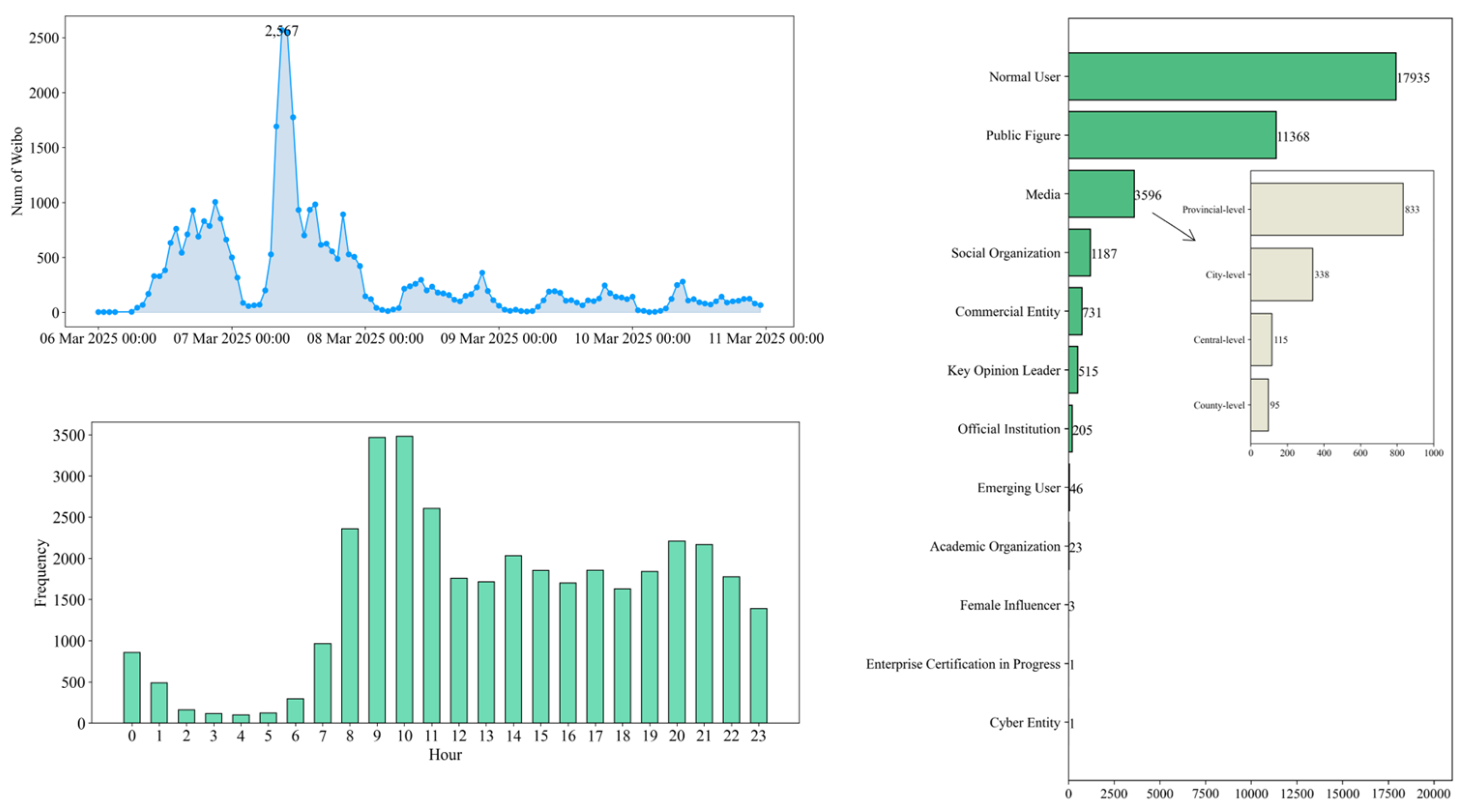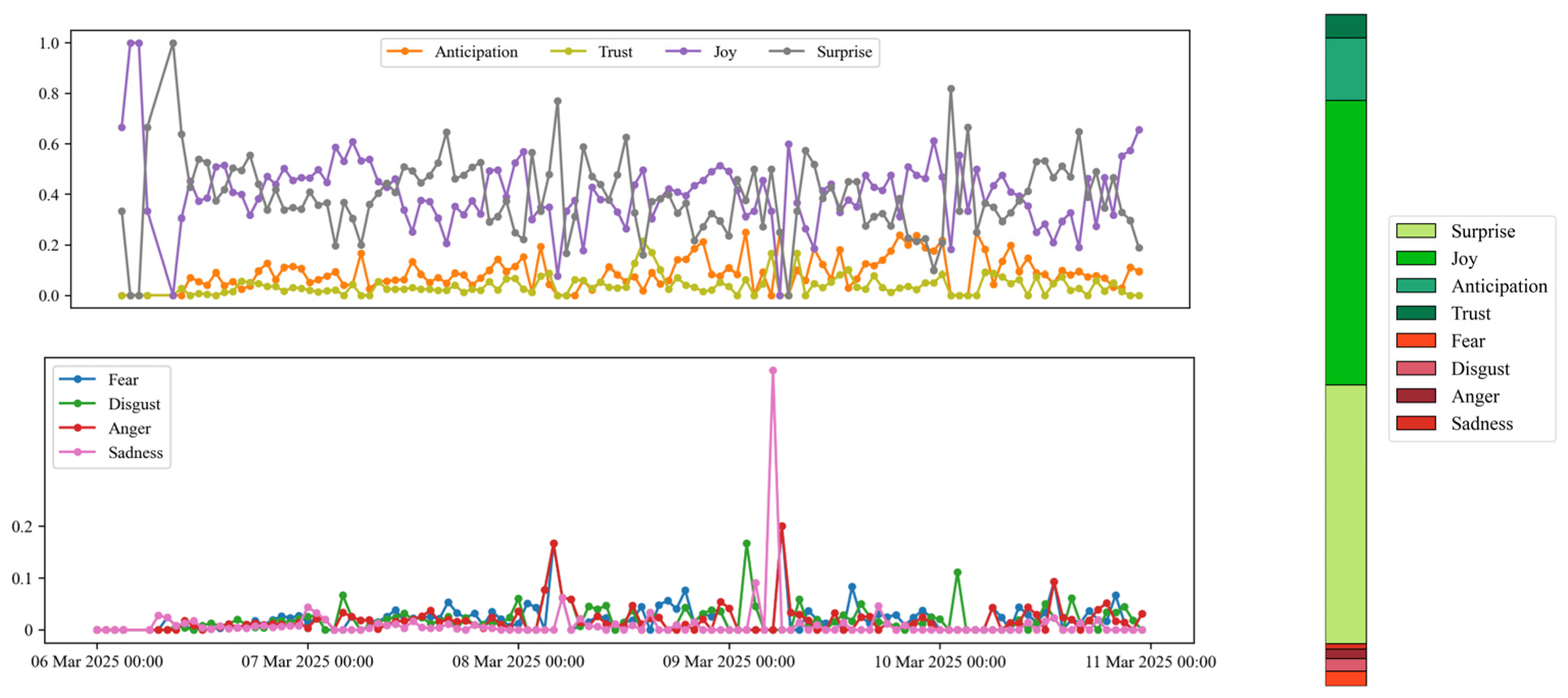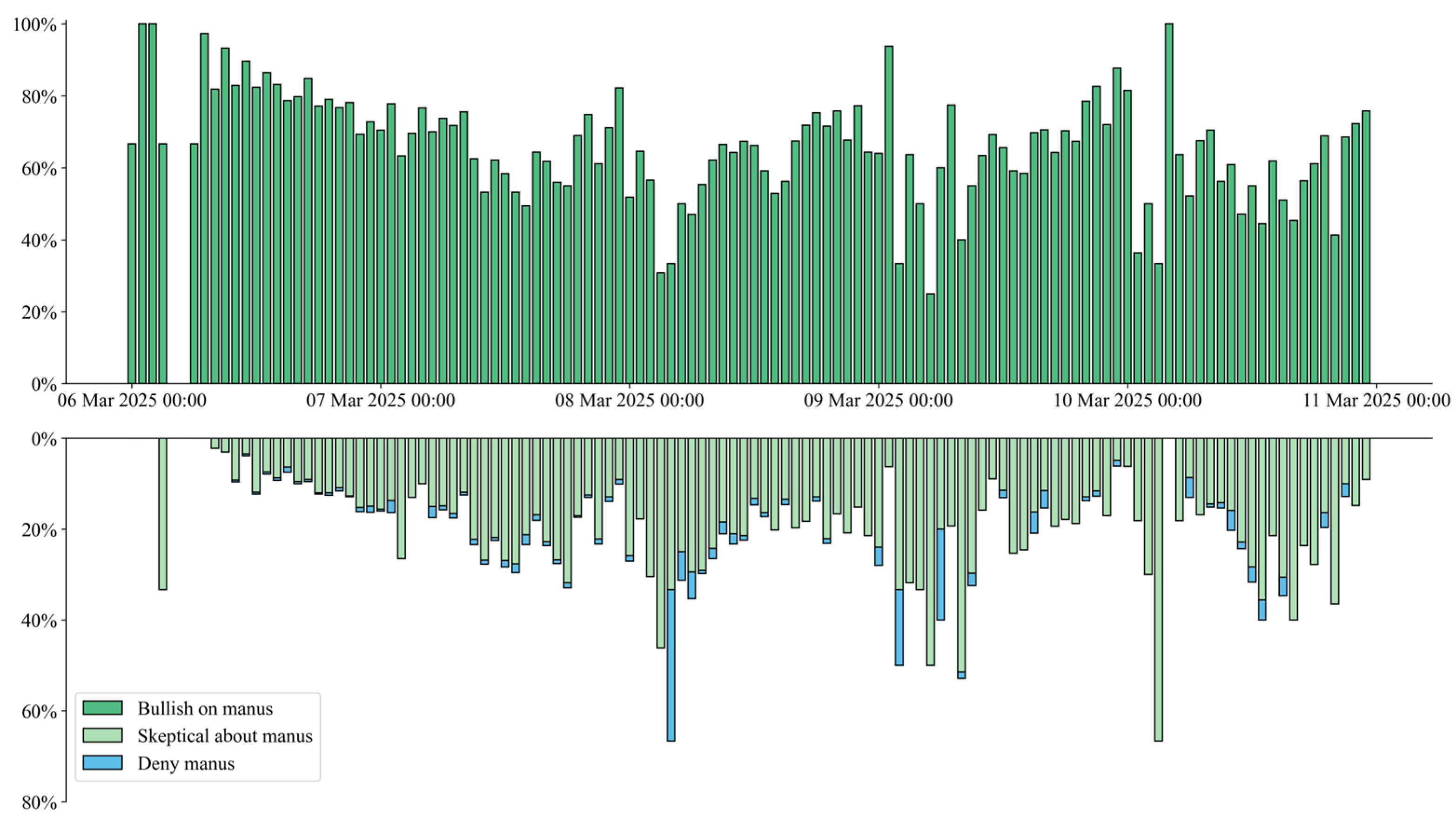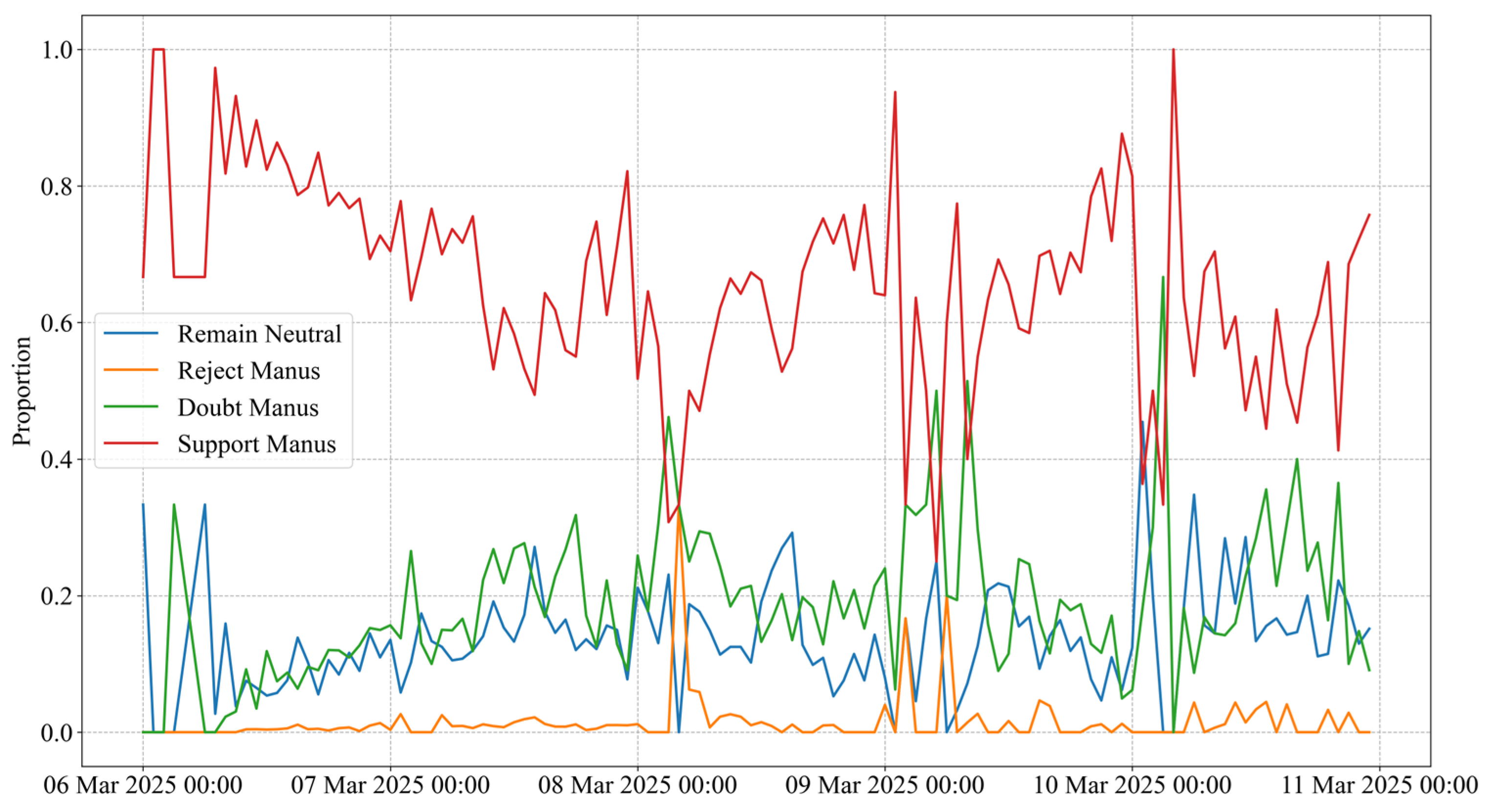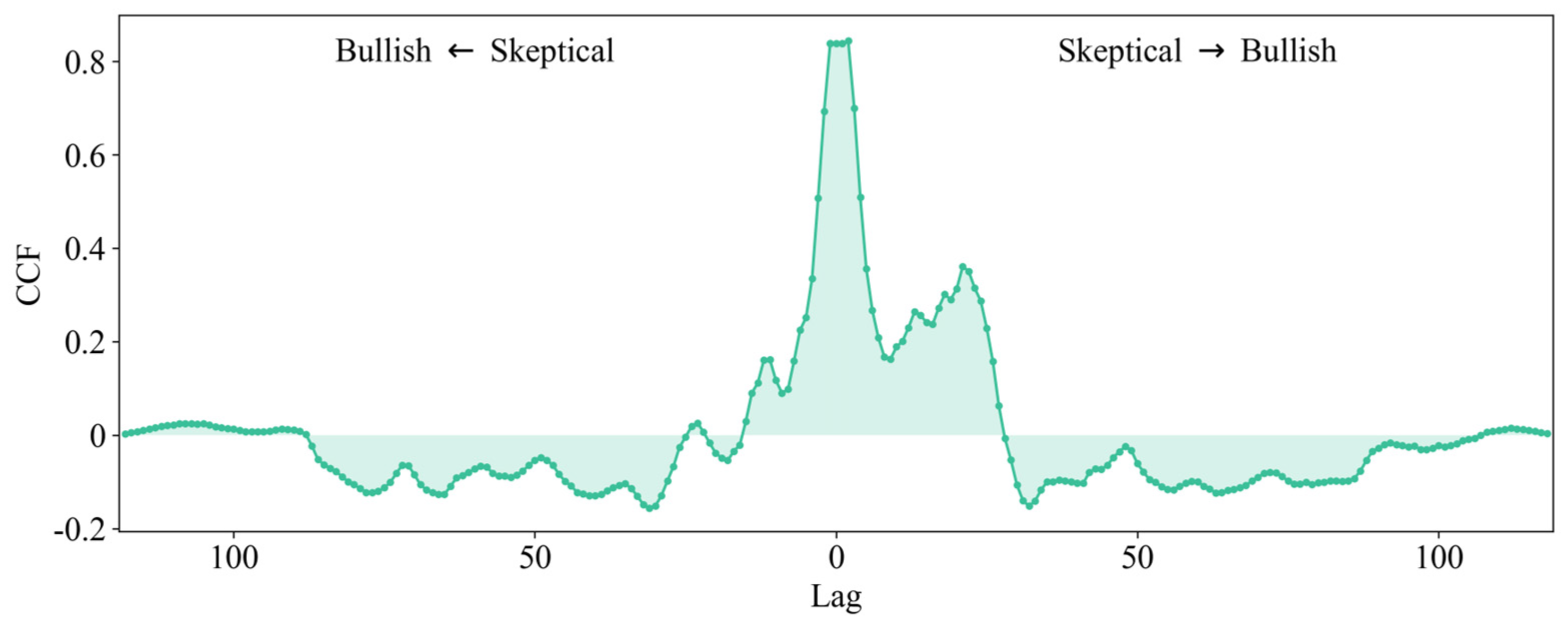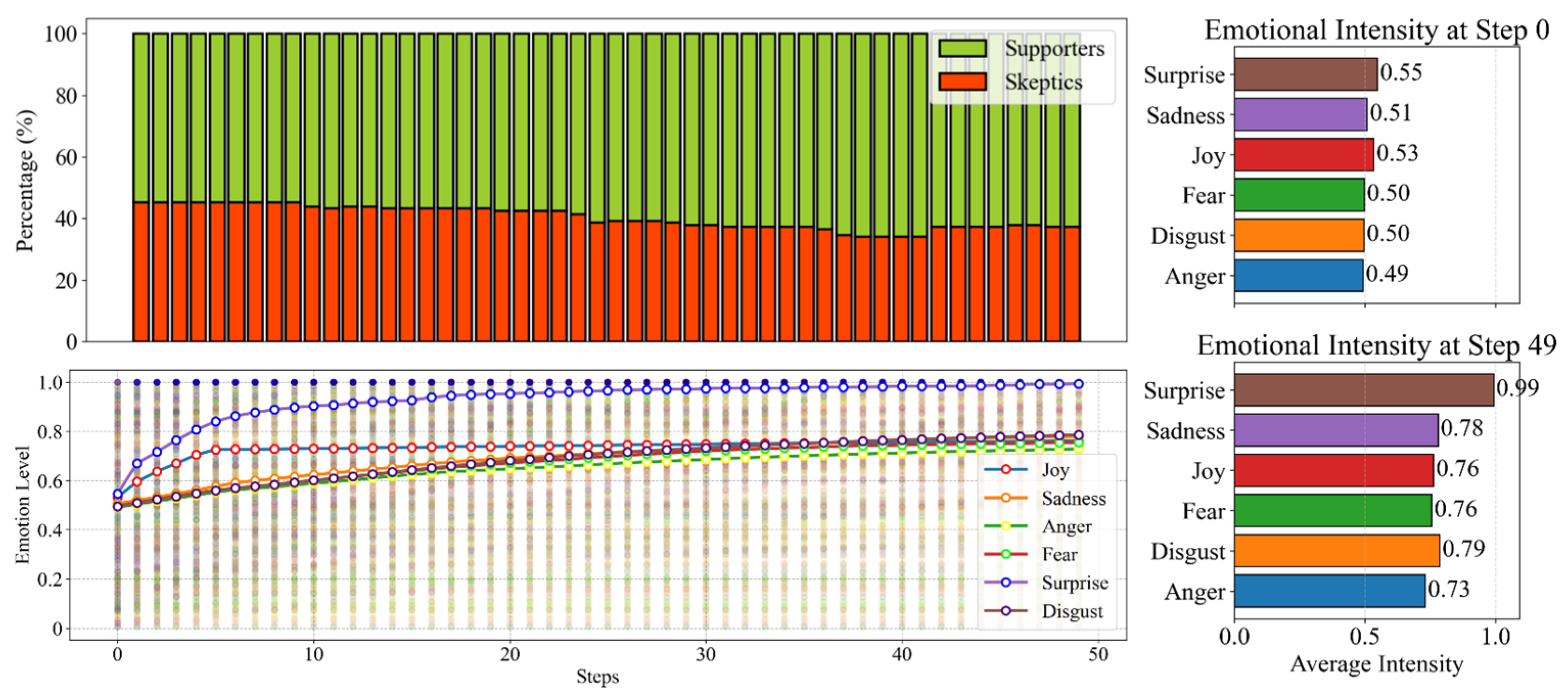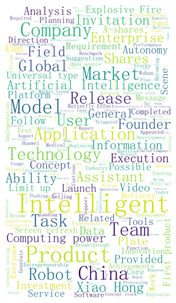1. Introduction
In recent years, the digital landscape has witnessed an unprecedented proliferation of technical discourse events that rapidly evolve through complex patterns of opinion formation, stance reversal, and emotional contagion [
1]. These phenomena represent significant challenges for traditional public opinion theories, as they often exhibit dynamics that transcend conventional understanding of how public discourse unfolds [
2,
3,
4]. The Manus technology controversy of March 2025 presents a compelling case study of such complex dynamics, where an AI product initially celebrated as a breakthrough innovation rapidly faced technical scrutiny and public backlash, creating a dramatic stance reversal within a remarkably short timeframe.
The classical Spiral of Silence theory, first proposed by Noelle-Neumann [
5], suggests that individuals who perceive their opinions to be in the minority tend to remain silent due to fear of isolation. However, contemporary digital environments appear to foster what scholars have begun to identify as a “Counter-Spiral of Silence” phenomenon, wherein perceived minority opinions can gain surprising momentum through lagged emotional interactions and digital amplification mechanisms [
6,
7]. These dynamics are particularly evident in technical discourse events, where specialized knowledge, information asymmetries, and rapid digital diffusion create unique conditions for public opinion formation [
8].
The intersection of technological discourse with nationalist sentiment—often characterized as “technological nationalism”—further complicates these dynamics in distinctive ways. Technological nationalism, wherein technological achievements become proxies for national pride and identity, creates a charged discursive environment where stance expressions carry additional emotional and identity-based dimensions beyond mere technical assessments. In such contexts, lagged interactions between skeptical and supportive stances are particularly pronounced, as challenges to technological claims may be perceived not simply as technical criticisms but as challenges to collective identity narratives. This creates asymmetric response patterns where skeptical expressions trigger disproportionate counter-mobilization from supporters who are motivated by both technical and identity-based concerns. The Manus controversy exemplifies this dynamic, where initial technical scrutiny quickly evolved into broader discourse about national innovation capabilities and competitive positioning in global AI development, creating distinctive temporal patterns in stance expression and emotional intensification that traditional spiral of silence theory struggles to explain.
The emergence of new computational methodologies—particularly Large Language Models (LLMs) and Agent-Based Modeling (ABM)—offers unprecedented opportunities to analyze these complex phenomena with greater precision [
9,
10]. While traditional sentiment analysis based on BERT models has provided valuable insights into public opinion dynamics [
11,
12], LLMs demonstrate superior capabilities in capturing nuanced stances and emotional states across diverse discourse contexts [
13]. Similarly, ABM approaches allow researchers to simulate the microinteractions that generate emergent patterns of opinion formation and diffusion [
14,
15], providing a computational framework for testing theoretical propositions about digital discourse dynamics.
This paper presents a comprehensive data-driven analysis of stance interactions and counter-silence phenomena in technical public opinion events, using the Manus controversy as a focal case study. By integrating advanced stance detection through LLM-based classification with agent-based simulation of opinion dynamics, we aim to address three central research questions: (1) How do lagged stance interactions manifest in technical public opinion events? (2) What mechanisms drive the counter-spiral of silence phenomenon in digital environments? (3) How can agent-based modeling illuminate the microprocesses that generate macro-level patterns of opinion reversal?
Our investigation follows a three-phase methodological approach. First, we conduct a descriptive statistical analysis of stance distribution and temporal evolution across the Manus controversy timeline, identifying key inflection points in public discourse. Second, we employ both traditional BERT models and advanced LLMs to classify stance positions and emotional expressions in social media content, demonstrating the superior performance of LLMs in capturing stance nuances. Third, we develop an agent-based model that incorporates emotional dynamics, network effects, and silence thresholds to simulate the emergence of opinion patterns observed in the empirical data.
The significance of this research extends beyond academic interest in digital discourse dynamics. Understanding the mechanisms that drive stance reversal and counter-silence phenomena has important implications for technology communication, crisis management, and digital platform governance [
16,
17]. By illuminating how lagged emotional interactions influence public discourse trajectories, this research contributes to a more sophisticated theoretical framework for analyzing and potentially anticipating the evolution of public opinion in contemporary digital environments [
18].
The remainder of this paper is structured as follows.
Section 2 reviews relevant literature on the Spiral of Silence theory, stance detection in technical discourse, and agent-based approaches to social media dynamics.
Section 3 details our data collection, model comparison methodology, and agent-based model design.
Section 4 presents our empirical findings regarding temporal patterns, lagged stance interactions, and simulation results.
Section 5 discusses theoretical and practical implications, while
Section 6 concludes with contributions, limitations, and directions for future research.
3. Data and Methods
3.1. Data Collection
This research focuses on the social media public opinion triggered by the Manus technology controversy, systematically collecting high-quality opinion text data. The data collection period was determined to be from 6 March to 10 March 2025, spanning five days. This time window, as indicated by Baidu Index data, captured a complete cycle from “Manus product announcement” to the controversy’s peak and subsequent stabilization, allowing for a comprehensive analysis of the technical public opinion from emergence to peak and cooling phases.
Data collection primarily focused on the Weibo platform, which features a diverse user base and active interactions, providing a relatively comprehensive reflection of public perception and evaluation of Manus. The collection process utilized custom-developed Python 3.8-based web crawlers combined with Weibo’s open API, using “Manus”, “Monica.im”, and “AI Agent” as search keywords to obtain microblog texts containing these terms. To ensure data completeness and representativeness, multiple strategies were employed: on the one hand, an incremental collection method was implemented, with data crawling every 4 h to accurately capture real-time changes in public opinion; on the other hand, in-depth crawling was conducted for popular microblogs (those with repost counts, comment counts, or like counts exceeding 1000) to obtain their complete textual content and interaction information.
The data cleaning and preprocessing stage primarily included: first, deduplication of the original data, removing completely identical reposted content; second, filtering advertisements, batch content published by bot accounts, and comments consisting solely of emoji without substantial content; third, standardizing text formats, processing special characters, URLs, and non-standard expressions. After these processes, a total of 36,932 valid Weibo text entries were obtained, constituting the core dataset for this research. To better illustrate the qualitative texture of these data, we present in
Table 1 a selection of representative posts categorized by stance, along with corresponding wordclouds that visualize dominant expressions within each group.
To ensure the reliability of subsequent analyses, user attribute data (including follower count, following count, user verification type, etc.) and interaction data (including repost count, comment count, like count, etc.), as well as timestamp information, were also collected to construct temporal evolution models and social network structures. These auxiliary data help characterize the heterogeneous features and interaction patterns of opinion subjects, providing an empirical foundation for agent-based modeling. A summary of key user attributes and stance distributions across different account types is provided in
Table 2, offering a descriptive overview of the heterogeneous participant landscape in this controversy.
3.2. Comparison of LLM and BERT Models in Stance and Sentiment Detection
To effectively analyze the complex stance positions and emotional expressions in the Manus controversy dataset, we conducted a comprehensive evaluation of different language models’ performance in both stance recognition and sentiment analysis tasks. Our comparison included two Large Language Models (LLMs)—GLM-4-Flash and DeepSeek-V3—and three variants of BERT models—BERT-base-chinese, RoBERTa-wwm, and MacBERT. This comparative analysis aimed to identify the most effective approach for processing large volumes of technical public opinion text data.
For the stance recognition task, we employed a three-category classification framework (stance-3) to identify whether a post expressed support for Manus (Bullish), skepticism about its capabilities (Skeptical), or outright rejection of its claims (Deny). For sentiment analysis, we implemented a more granular eight-category classification system (sentiment-8) encompassing primary emotions (joy, anger, sadness, fear) and secondary emotional states (anticipation, surprise, trust, disgust) based on established emotion classification frameworks.
To ensure rigorous evaluation, we manually annotated a subset of 2000 Weibo posts selected through stratified random sampling to maintain temporal and thematic representation. Three independent annotators with background knowledge in both AI technology and communication studies performed the annotation, achieving an inter-annotator agreement of 0.81 (Cohen’s Kappa). This annotated dataset was then split into training (70%), validation (15%), and testing (15%) sets for model development and evaluation.
As shown in
Table 3, our evaluation revealed substantial performance differences between LLM-based classifiers and traditional BERT models. The LLM approaches demonstrated notably superior performance, with DeepSeek-V3 achieving the highest accuracy in both stance recognition (0.83) and sentiment analysis (0.80) tasks. Among the BERT variants, RoBERTa-wwm consistently outperformed both the basic BERT-base-Chinese model and MacBERT, achieving accuracies of 0.73 for stance recognition and 0.71 for sentiment analysis.
The performance gap between LLMs and BERT models was particularly pronounced in handling complex stance positions and nuanced emotional expressions. For instance, in the stance recognition task, DeepSeek-V3 achieved an F1-score of 0.75 compared to BERT-base-Chinese’s 0.51, representing a 47% improvement. This substantial performance differential can be attributed to LLMs’ enhanced capability to interpret contextual cues, technical terminology, and implicit stance signals present in the data.
The superior performance of LLMs over BERT models can be attributed to several specific advantages in processing technical discourse. First, LLMs benefit from substantially larger context windows (32K tokens for DeepSeek-V3 compared to 512 tokens for BERT), enabling them to process entire posts with surrounding conversation threads rather than isolated text fragments. This is particularly important for technical controversies where stance positions often depend on broader contextual references. Second, LLMs demonstrate superior capabilities in handling technical terminology and jargon through their massive pre-training exposure to specialized domains, allowing them to recognize stance signals in technically nuanced expressions where BERT models often misclassify technical criticism as neutral content.
The performance difference is most pronounced when processing three specific linguistic patterns common in technical discourse: (1) implicit stance expressions using domain-specific metaphors or analogies, where LLMs significantly outperform BERT models; (2) stance positions expressed through technical comparisons or benchmarking language, where traditional models struggle with the specialized vocabulary; and (3) emotionally nuanced technical assessments combining factual claims with subjective evaluations, which require the contextual understanding LLMs provide. This pattern suggests that LLMs’ advantage increases with the technical complexity and implicit nature of the stance expressions, making them particularly valuable for analyzing technical controversies where opinions are often embedded within sophisticated technical arguments.
Figure 1 illustrates the training progression of the three BERT variants across ten epochs for both stance and sentiment classification tasks. The accuracy curves demonstrate that RoBERTa-wwm consistently outperformed the other BERT variants throughout the training process, with more rapid initial convergence and better generalization to testing data. However, all BERT models exhibited a notable gap between training and testing accuracies, suggesting limited generalization capabilities when applied to unseen data.
The improved performance of LLMs over BERT models can be attributed to several factors. First, LLMs benefit from significantly larger pre-training corpora and more complex model architectures, enabling them to capture deeper semantic relationships. Second, their mixture-of-experts architecture (in DeepSeek-V3) and long-context windows (in GLM-4-Flash) provide advantages in processing longer text segments with complex contextual dependencies. Third, LLMs demonstrate superior capability in adapting to domain-specific language patterns through in-context learning, which is particularly valuable when analyzing technical discourse.
Based on these comparative results, we selected DeepSeek-V3 as our primary classifier for processing the complete Manus controversy dataset. This model was applied to classify all 36,932 posts in our corpus, generating stance and sentiment labels that served as the foundation for subsequent temporal analysis of opinion evolution and lagged interaction effects. The resulting classified dataset enabled us to track how different stance positions and emotional expressions evolved throughout the controversy timeline, providing essential data for understanding the Counter-Spiral of Silence phenomenon observed in this technical public opinion event.
3.3. Agent-Based Model Design
To investigate the micro-level mechanisms driving lagged stance interactions and counter-spiral phenomena in technical discourse, we developed a comprehensive agent-based model simulating opinion formation dynamics within networked communication environments. The model integrates theoretical insights from complex systems theory, emotional contagion dynamics, and spiral of silence mechanisms to create a computational framework capable of reproducing the emergent patterns observed in empirical data.
Our agent-based simulation represents each social media participant as an autonomous agent characterized by both stance attributes and multidimensional emotional states. Each agent possesses an initial opinion value (ranging from −1 to 1, with positive values supporting Manus and negative values questioning it), individualized sensitivity thresholds (normally distributed around 0.7), and a seven-dimensional emotional state vector representing the intensity of discrete emotions (joy, sadness, anger, fear, surprise, disgust, and neutral). This design allows for modeling the complex interplay between cognitive positions and affective responses that characterizes real-world discourse.
To capture the heterogeneous structure of online communication networks, we implemented a hybrid network topology combining three complementary network generation algorithms. The model incorporates a connected caveman graph (50 clusters of 10 nodes, totaling 500 nodes) representing tight-knit communities, a Barabási-Albert scale-free network (500 nodes with 3 edges per new node) capturing preferential attachment dynamics, and a Watts-Strogatz small-world network (500 nodes, 4 initial neighbors per node, rewiring probability of 0.1) modeling the characteristic combination of high clustering and short path lengths observed in social media environments. These networks were interconnected through strategic bridge connections (30 edges randomly created between subgraphs) to facilitate information flow across community boundaries, creating a realistic approximation of social media interaction structures. The total network size of 1500 nodes ensures sufficient topological complexity to fully manifest the power-law degree distribution characteristic of scale-free networks and the high clustering coefficient with short average path length features of small-world networks.
The behavioral mechanisms governing agent interactions implement core theoretical principles of the spiral of silence theory while extending them to account for digital communication affordances. During each simulation step, agents observe their local network neighborhood and assess the proportion of neighbors holding similar opinions. When this proportion exceeds their individualized sensitivity threshold (with small random variations to capture decision stochasticity), agents express their opinions and influence neighboring agents; otherwise, they remain silent and increment their silence duration counter. This threshold-based expression mechanism operationalizes the fundamental fear-of-isolation principle central to the Spiral of Silence theory.
A key innovation in our model is the introduction of dynamic opinion adjustment mechanisms that capture both silence-induced conformity and counter-spiral phenomena. Agents maintaining prolonged silence (exceeding 10 time steps) experience gradual opinion drift toward the perceived majority position, implementing the classical spiral of silence effect. Simultaneously, the model incorporates emotion-mediated influence dynamics, where opinion expression triggers both stance and emotion diffusion to neighboring agents, with influence magnitudes modulated by current emotion intensities, stance similarities, and global emotion distributions. This emotional contagion mechanism provides a computational pathway for the counter-spiral effects observed in empirical data.
In terms of interaction mechanics, we incorporated emotion-driven influence functions, where emotional intensity modulates both opinion transmission and emotional contagion across ties. For example, surprise and joy emotions—when prevalent—act as amplifiers of opinion shifts. The emotional intensity of an agent directly affects the strength of opinion influence on neighbors, with highly emotional agents exerting stronger influence regardless of their stance position. This creates asymmetric influence patterns that can generate non-linear opinion dynamics resembling those observed in empirical data.
To simulate the dynamic information environment characteristic of real-world technical controversies, we implemented randomized external influence events affecting subsets of the agent population, particularly during early simulation stages. External shocks (e.g., viral criticism events) and asymmetrical feedback loops are introduced to reflect real-world information disturbances. Notably, early steps include exogenous surges in “surprise” intensity to emulate unexpected revelations or scandals that commonly characterize technical controversy events. In our model, the intensity of emotional contagion is influenced by the global emotional distribution; for instance, when an emotion such as surprise becomes widespread in the network, its propagation rate is correspondingly enhanced, helping to explain the emotional clustering effects observed in empirical data.
The simulation was executed for 50 discrete time steps, providing sufficient temporal scope to observe both transient dynamics and emergent equilibrium states. Comprehensive data collection captured the complete state of each agent at every time step, enabling detailed analysis of opinion trajectories, emotional diffusion patterns, and network structural evolution. This rich dataset allowed for both aggregate-level examination of opinion distribution dynamics and individual-level analysis of behavioral transitions, providing a computational laboratory for exploring the micro-mechanisms underlying observed macro-level discourse patterns. This model design enables us to examine how minority expressions (e.g., skepticism) can catalyze network-level mobilization and opinion reversals, providing computational support for the counter-spiral hypothesis introduced earlier.
4. Results
4.1. Descriptive Statistics and Temporal Evolution of Public Opinion
Analysis of the Manus controversy dataset reveals distinctive temporal patterns and user engagement dynamics throughout the five-day observation period. As shown in
Figure 2, the controversy exhibited two prominent activity peaks: an initial surge on 6–7 March, followed by a substantially larger spike on 7 March, reaching approximately 2567 posts in a single hour. This dual-peak pattern is characteristic of technical controversies where initial product announcements generate moderate interest, followed by explosive engagement once technical scrutiny and detailed evaluations emerge. After the second peak, activity levels demonstrated a gradual decline with periodic minor fluctuations, suggesting sustained but diminishing interest in the controversy.
The hourly distribution analysis indicates that user engagement was most intensive during evening hours (8 PM to 10 PM), with peak activity occurring around 9 PM (3467 posts) and 10 PM (3480 posts). This temporal pattern aligns with typical social media usage behaviors in China, where evening hours represent prime engagement periods. Notably, even during low-activity hours (3 AM to 5 AM), the controversy maintained a baseline of approximately 100–150 posts per hour, indicating the sustained nature of public interest in this technical event.
Examination of user type distribution reveals that normal users constituted the predominant participant group (17,935 posts, 48.6%), followed by public figures (11,368 posts, 30.8%), and media accounts (3596 posts, 9.7%). Among media participants, provincial-level outlets demonstrated the highest engagement (833 posts), significantly outpacing both city-level media (338 posts) and central-level media (115 posts). This prominent role of provincial media suggests that regional information channels played a crucial function in amplifying and framing the controversy, potentially reflecting regional interests in technological innovation narratives.
The emotional dynamics of the controversy, depicted in
Figure 3, exhibit distinct patterns across different sentiment categories. Positive emotions, particularly joy and surprise, dominated the early stages of the controversy, with joy reaching near-maximum intensity (approximately 1.0) during the initial hours of 6 March. This was quickly followed by a spike in surprise sentiment, suggesting an initial phase of excitement and unexpected interest in the Manus announcement. Throughout the observation period, joy and surprise continued to oscillate between 0.3 and 0.6 intensity levels, maintaining primacy over other emotional expressions.
Negative emotions, including anger, disgust, fear, and sadness, remained comparatively subdued throughout most of the observation period, generally registering below 0.1 in intensity. However, notable spikes in anger (reaching 0.4) and sadness (reaching 0.5) occurred on 9 March, coinciding with the emergence of technical criticisms and revelations about potential code misappropriation. These emotional flares represent critical moments in the controversy’s evolution, marking transitions in public sentiment as new information challenged initial positive perceptions.
The stance analysis presented in
Figure 4 provides perhaps the most revealing insights into the controversy’s evolution. Initial discourse was overwhelmingly positive, with bullish stances accounting for over 90% of expressions during the first hours of 6 March. This extremely high initial support gradually moderated but remained dominant (60–80%) throughout 6 March and early 7 March. However, a significant transition occurred during late 7 March and into 8 March, when skeptical stances began to gain substantial ground, increasing from under 20% to approximately 30–40% of expressions.
The most dramatic stance shift occurred on 8 March, when denial stances peaked at approximately 65% during a brief period, representing the controversy’s inflection point. This coincided with the public revelation of technical evidence challenging Manus’s originality claims. Following this critical juncture, stance distribution entered a more volatile phase, with bullish positions fluctuating between 40% and 80%, while skeptical and denial positions demonstrated responsive oscillation patterns.
Throughout the controversy’s final days (9–10 March), stance distribution stabilized into a pattern of persistent contestation, with bullish stances maintaining a diminished but still dominant position (averaging 55–60%), counterbalanced by substantial skeptical stances (25–30%) and a smaller but consistent proportion of outright denial positions (10–15%). This final equilibrium state represents a significant moderation from the initial near-unanimous positive stance, illustrating the evolution of public opinion as technical evidence and critical evaluation entered the discourse.
4.2. Lagged Interaction Effects of Stance
The temporal dynamics of stance positions in the Manus controversy reveal complex interaction patterns that extend beyond simple opinion distribution. As illustrated in
Figure 5, the proportion of different stance positions exhibits distinctive fluctuation patterns throughout the observation period. The support for Manus (represented by the red line) dominated the early discourse with proportions exceeding 0.8 during the first day of the controversy. However, this initially strong positive position experienced several notable declines, particularly on 8 March when it temporarily dropped to approximately 0.45, coinciding with significant increases in both skeptical and neutral positions.
What emerges from this temporal analysis is a striking pattern of stance interactions characterized by rapid responsive shifts. Specifically, whenever doubt about Manus (green line) experiences a substantial increase, support for Manus typically demonstrates a corresponding surge shortly thereafter. This pattern is particularly evident during several key moments: on 8 March, when doubt reached approximately 0.45, it was followed by a support rebound to 0.75; on 9 March, when a doubt peak reached 0.3, it was followed by a support surge to nearly 0.95; and again, on 10 March, multiple doubt increases were consistently followed by support rebounds.
This observation suggested the presence of systematic lagged interaction effects between opposing stance positions. To formally test this hypothesis, we conducted a cross-correlation function (CCF) analysis between the proportions of bullish (positive) and skeptical stance positions across the entire time series.
Figure 6 displays the results of this analysis, with the horizontal axis representing the lag between the two time series (measured in 15-min intervals) and the vertical axis showing the correlation coefficient value.
The CCF analysis reveals a striking asymmetric pattern. When skeptical stances lead bullish stances (positive lag values on the right side of the graph), we observe substantial positive correlation coefficients peaking at approximately 0.85 at around a 10–15 interval lag. This indicates that increases in skeptical sentiment are strongly associated with subsequent increases in bullish sentiment after approximately 2.5–3.75 h. This pattern suggests a consistent “counter-response” dynamic where expressions of doubt trigger defensive or supportive responses from those holding positive views about Manus.
Conversely, when bullish stances lead skeptical stances (negative lag values on the left side), we observe predominantly negative correlation coefficients, reaching approximately −0.15. This negative correlation indicates that increases in positive sentiment tend to be followed by decreases in skeptical sentiment, though this relationship is considerably weaker than the positive correlation in the opposite direction.
The asymmetric nature of these lagged correlations reveals a fundamental characteristic of stance dynamics in this technical controversy: skeptical positions appear to function as powerful triggers that stimulate responsive expression from those holding positive views, while positive expressions exert a milder suppressive effect on subsequent skeptical expressions. This asymmetry challenges simple conceptions of the spiral of silence, suggesting instead a complex “counter-spiral” phenomenon where perceived challenges to a dominant position mobilize defensive expression rather than inducing silence.
The strength of the positive correlation coefficient (reaching 0.85) indicates that this is not merely a statistical artifact but represents a robust pattern of interaction between opposing stance positions. The temporal specificity of the lag relationship—peaking at approximately 10–15 intervals—further suggests a systematic response dynamic rather than random fluctuation. This lagged interaction effect provides empirical evidence for the counter-spiral of silence phenomenon hypothesized in our research framework, demonstrating how in digital technical discourse, expressions of minority or challenging views can trigger amplified expression from those holding majority or challenged positions.
4.3. Agent-Based Simulation of Sentiment and Stance Formation and Counter-Silence Dynamics
Building upon our empirical findings of lagged stance interactions, we implemented an agent-based simulation to explore the micro-level mechanisms that generate the observed counter-spiral phenomena. The simulation results, depicted in
Figure 7 and
Figure 8, provide computational evidence for how individual agent behaviors and network structures evolve to produce the macro-level patterns identified in our empirical analysis.
Figure 7 illustrates the simulated evolution of stance proportions and emotional intensities over 50 time steps. The upper panel shows the progressive shift in the ratio between supporters and skeptics of Manus. Initially, the simulation was configured with approximately 45% skeptics and 55% supporters, reflecting the early distribution observed in the empirical data. As the simulation progressed, a notable transition occurred, with skeptic proportions gradually declining to approximately 38% by step 50, while supporter proportions increased to 62%. This trajectory mirrors the counter-spiral phenomenon observed in the actual controversy, where challenges to the dominant position ultimately triggered reinforcement rather than erosion of that position.
The emotional dynamics displayed in the lower panel of
Figure 7 reveal how different emotions evolve throughout the simulation. Surprise emerges as the most intensified emotion, showing a rapid increase from an initial value of 0.55 to nearly 0.99 by step 15, after which it stabilizes at maximum intensity. This dominant surprise effect aligns with our empirical findings, where surprise played a crucial role in the discourse evolution. Joy demonstrates a more moderate yet steadily increasing trajectory, rising from 0.53 to 0.80 by the final step. The negative emotions—sadness, anger, fear, and disgust—all show gradual intensification from their initial values (ranging from 0.49 to 0.51) to final values between 0.73 and 0.87.
The comparison of emotional intensities between step 0 and step 49, displayed on the right side of
Figure 7, quantifies these transformations. While all emotions experienced intensification, surprise showed the most dramatic increase (from 0.55 to 0.99), followed by disgust (0.50 to 0.87) and sadness (0.51 to 0.87). This differential emotional evolution suggests that controversy discourse generates asymmetric emotional responses, with surprise functioning as a primary driver of engagement and emotional contagion.
Figure 8 provides visualization of the network structures underlying the simulation, offering insights into how agent interactions shape opinion formation. The initial network structure (
Figure 8a) displays the hybrid topology incorporating caveman, Barabási-Albert, and Watts-Strogatz components, with nodes colored according to their dominant emotions. At this initial stage, the emotional distribution appears relatively random, with some clustering of joy (blue) and surprise (purple) evident in certain network regions.
As the simulation progresses to its final state, the network visualization by sentiment (
Figure 8b) reveals significant emotional clustering and community formation. Nodes dominated by joy and surprise form distinct communities, with surprise-dominated nodes (purple) appearing particularly central in the network structure. This clustering effect demonstrates how emotional contagion operates through network connections, leading to localized emotional homogeneity and global emotional diversity.
The stance-based visualization of the evolved network (
Figure 8c) provides the most direct evidence for the counter-spiral phenomenon. Supporters of Manus (green nodes) have formed several large, densely connected communities that dominate the network structure, while skeptics (red nodes) appear more fragmented and peripheral. This spatial distribution illustrates how the counter-spiral process manifests structurally, with supporters forming reinforcing communities that strengthen their collective position against skeptical challenges.
The expanded network size (1500 nodes total) allowed us to observe these phenomena with greater clarity and statistical reliability. The scale-free properties of the Barabási–Albert component are evident in the presence of highly connected hub nodes that facilitate rapid information spread, while the small-world characteristics of the Watts–Strogatz component enable efficient emotion propagation across otherwise distant network regions. The connected caveman structure creates tightly-knit communities that reinforce shared stances and emotional states, contributing to the formation of opinion enclaves resistant to outside influence.
The simulation results provide computational validation for the lagged interaction effects observed in our empirical analysis. The agent-based model successfully reproduces several key phenomena: (1) the gradual increase in supporter proportions following initial skeptical challenge; (2) the differential evolution of emotional intensities, with surprise emerging as dominant; (3) the formation of emotion-based and stance-based communities within the network structure; and (4) the structural advantage gained by the supporter position through more effective community formation.
These findings suggest that the counter-spiral phenomenon emerges from the interaction of several mechanisms: emotional contagion, where emotions—particularly surprise—spread rapidly through network connections; preferential attachment, where agents with similar positions tend to form denser connection patterns; and counter-mobilization, where challenges to a position trigger defensive expression rather than silence. The simulation thus provides a computational mechanism for understanding how the lagged stance interactions observed in the empirical data might emerge from individual agent behaviors operating within complex network structures.
5. Discussion
The empirical findings and simulation results from our analysis of the Manus controversy offer significant insights into the dynamics of stance formation and opinion reversal in contemporary technical discourse environments. Our observation of lagged stance interactions and counter-spiral phenomena invites deeper theoretical reflection on how digital communication environments reconfigure traditional public opinion processes.
5.1. Lagged Stance Interactions as Dynamic Catalysts
The cross-correlation analysis revealing strong positive associations between skeptical expressions and subsequent bullish responses (r = 0.85 at 10–15 interval lag) illuminates a fundamental characteristic of technical discourse dynamics that challenges conventional understanding of opinion formation. This pronounced lagged interaction effect demonstrates that, contrary to traditional conceptions of minority opinion suppression, skeptical challenges in technical contexts appear to function as catalytic triggers that mobilize defensive responses from supporters. The asymmetric nature of this relationship—with skeptical expressions more powerfully influencing subsequent bullish expressions than the reverse—suggests a fundamentally reactive pattern of discourse engagement where perceived threats to dominant technical narratives generate disproportionate counter-mobilization.
This finding aligns with but extends recent theoretical work on “reactance theory” in digital environments, where psychological reactance to perceived opinion threats generates amplified counter-responses rather than opinion moderation. In the Manus case, the temporal specificity of this lag relationship (peaking at approximately 2.5–3.75 h) provides particularly valuable insight into the operational timescale of digital counter-response dynamics, offering a potential “response window” during which strategic communication interventions might be most effective.
5.2. Counter-Spiral of Silence in Technical Discourse
Before analyzing how the Manus controversy deviates from classical spiral dynamics, it is essential to reiterate the conceptual logic of the original model. Noelle-Neumann theorized that individuals continuously scan their environment to assess opinion climates. When perceiving themselves to be in the minority, they anticipate social exclusion, leading to self-silencing. Over time, this silencing reinforces the dominance of the perceived majority, creating a spiral. In our study, however, we observe the opposite dynamic: expressions of doubt do not disappear, but instead provoke intensified, emotionally driven responses from supportive actors. This suggests a reversal of the spiral logic—what we define as a “counter-spiral”—where minority expressions act as triggers, not inhibitors, of further discourse. The mechanisms driving this reversal appear rooted in digital affordances (e.g., low-cost rebuttals, real-time feedback) and the emotional architecture of controversy, particularly the mobilizing role of surprise and indignation. Thus, the Manus case reflects a structurally inverted version of the spiral: a reactive, nonlinear escalation rather than a suppression spiral.
The observed counter-spiral phenomenon—where challenges to the dominant position ultimately trigger reinforcement rather than erosion of that position—fundamentally contradicts classical Spiral of Silence predictions. In traditional Spiral of Silence theory, the perception of one’s opinion as a minority should lead to self-censorship and silence. Yet, our agent-based simulations successfully reproduced empirical patterns showing how supporter communities formed increasingly dense network structures in response to skeptical challenges, ultimately strengthening rather than weakening their collective position.
This counterintuitive finding can be explained through several mechanisms illuminated by our simulation results. First, emotional contagion—particularly surprise—appears to function as a potent amplifier of stance expression, spreading rapidly through network connections and intensifying engagement with contested positions. Second, homophilous clustering generates protected discursive spaces where like-minded individuals reinforce shared positions, creating what might be termed “opinion sanctuaries” resistant to external pressure. Third, the multi-channel nature of digital communication environments enables simultaneous expression across diverse platforms, reducing the fear of isolation that underpins traditional silencing mechanisms.
5.3. Technological Nationalism and Cognitive Asymmetries
The Manus controversy exhibits characteristics of broader technological nationalism processes, revealing fundamental cognitive asymmetries in how diverse stakeholders interpret technological innovations. The controversy’s essence reflects a significant cognitive gap in the AI democratization process: public expectations aligned with “ChatGPT-like disruption” colliding with an industry reality of incremental engineering optimization. The opinion reversal trajectory (6 March viral emergence → 7 March account suspension → 13 March code leak) reveals two critical patterns underlying technological discourse dynamics.
First, technical knowledge asymmetry intensifies emotional polarization. Our data demonstrates how ordinary users exhibited romantic conceptualizations of technical terminology such as “multi-agent architecture”, while developer communities focused on practical constraints such as token costs and API dependencies. This discrepancy represents a form of “technological expectation gap” that generates emotional volatility when public imagination confronts technical limitations. The emotional intensification observed in our simulation results—where surprise emerged as the dominant emotion, increasing from 0.55 to 0.99—reflects this collision between idealized technological expectations and emerging technical realities.
Second, digital platforms’ inherent affordances accelerate technological demystification. The “emotional resonance-stance reversal” mechanism documented in our analysis enabled technical flaws to complete a full “mythmaking–questioning–rationalization” cycle within 48 h. This accelerated demystification process represents a distinctive feature of contemporary technical discourse environments, where the traditional vetting mechanisms of scientific and technical communities have been partially supplanted by rapid, emotionally-driven public evaluation cycles.
These findings carry significant implications for both theory development and practical communication strategies in technical contexts. For theoretical advancement, our results suggest the need for a fundamental reconsideration of silence dynamics in digital environments, particularly regarding how network structure, emotional contagion, and technical knowledge disparities modulate traditional opinion expression processes. For practical application, our findings highlight the critical importance of managing technical expectation gaps, anticipating counter-response dynamics, and developing communication strategies attentive to the specific temporal windows during which stance interactions are most volatile.
The Manus case ultimately serves as a cautionary exemplar for the AI industry, highlighting how the dual pressures of “technological breakthrough anxiety” and “capital monetization imperatives” create precarious communication environments. Successful navigation of these environments requires a strategic balance between marketing volume and technical transparency, avoiding the increasingly common pattern where viral popularity immediately precipitates critical scrutiny and potential reputational collapse.
6. Conclusions
6.1. Theoretical Contributions
This research makes several significant theoretical contributions to understanding public opinion dynamics in digital environments. First, we have empirically documented and conceptually developed the “Counter-Spiral of Silence” phenomenon, demonstrating how digital communication environments can reverse traditional silencing mechanisms through interactions of emotional contagion, network structure, and stance dynamics. By identifying the robust positive cross-correlation between skeptical expressions and subsequent bullish responses, we provide quantitative evidence challenging classical assumptions about opinion minority behaviors.
Second, our integration of agent-based modeling with empirical stance analysis advances methodological approaches to studying opinion dynamics. The successful reproduction of observed counter-spiral patterns through computational simulation demonstrates how individual-level behavioral rules generate emergent macro-level discourse patterns that traditional analytical approaches struggle to explain.
Third, our research extends traditional spiral of silence theory by incorporating temporal dynamics and emotional contagion mechanisms specific to technical discourse environments. By documenting how emotions (particularly surprise) spread through network connections and modulate stance expression, we provide a more nuanced understanding of the affective dimensions underlying public opinion formation.
6.2. Practical Implications
Our findings offer valuable practical insights for technology developers, communication strategists, and platform governance. For technology companies, the documented lag period between skeptical challenges and supportive mobilization (approximately 2.5–3.75 h) provides a specific operational window during which strategic interventions might effectively address emerging criticisms before counter-mobilization intensifies discourse polarization.
For communication strategists, our identification of surprise as the dominant emotion in technical discourse offers guidance for message framing. The simulation results showing how surprise rapidly propagates through networks suggest that controlling narrative surprise elements may be crucial for managing discourse evolution. Additionally, the documented network clustering effects highlight the importance of engaging with diverse community structures rather than treating public opinion as homogeneous.
For platform governance, our research demonstrates how technical discourse evolves through distinctive patterns different from other forms of public opinion formation. The rapid progression from near-unanimous support to contested stance distribution within a compressed timeframe suggests potential benefits of implementing “cooling off” mechanisms or specialized moderation approaches for technically complex topics.
6.3. Limitations and Future Directions
While our research provides valuable insights into lagged stance interactions and counter-spiral phenomena, several limitations should be acknowledged. Our analysis focused on a single case study (Manus) within a specific platform (Weibo) and cultural context, limiting generalizability to other technologies or communication environments. The temporal scope was also constrained to the initial discourse formation period (five days), potentially missing longer-term evolutionary patterns. Additionally, our agent-based model, while improved, still employs simplified representations of user characteristics that may not fully capture the complexity of real-world discourse participation.
Based on these limitations, we propose the following specific research directions for future investigation:
- (1)
Cross-platform comparative research: Future studies should extend similar methodological approaches across multiple platforms (e.g., Zhihu, Bilibili, Twitter, Reddit) to examine how different platform affordances, moderation policies, and user demographics influence counter-spiral dynamics. Such comparative analysis could identify platform-specific factors that either amplify or attenuate counter-mobilization responses.
- (2)
Extended longitudinal analysis: Expanding the temporal scope to 30–60 days would enable investigation of how counter-spiral patterns evolve beyond initial controversy peaks, potentially revealing cyclical patterns, delayed effects, or eventual equilibrium states that our compressed observation period could not capture.
- (3)
Cultural and linguistic variation studies: Applying our computational framework to technical controversies across different cultural contexts (e.g., Western, East Asian, and Global South settings) would illuminate how technological nationalism and expectation gaps manifest differently across various innovation ecosystems and communication norms.
- (4)
Multi-method validation: Combining computational approaches with qualitative interviews of social media users involved in technical controversies would provide deeper insights into the psychological mechanisms underlying stance expression and emotional responses that cannot be fully captured through digital trace data alone.
- (5)
Intervention design and testing: Developing and evaluating specific communication strategies during the critical response window (2.5–3.75 h) identified in our study would offer practical guidance for technology communicators seeking to moderate polarization during emerging controversies.
These research directions would address the limitations of our current study while extending both theoretical understanding and practical approaches to navigating the increasingly complex landscape of public engagement with technological innovation.

